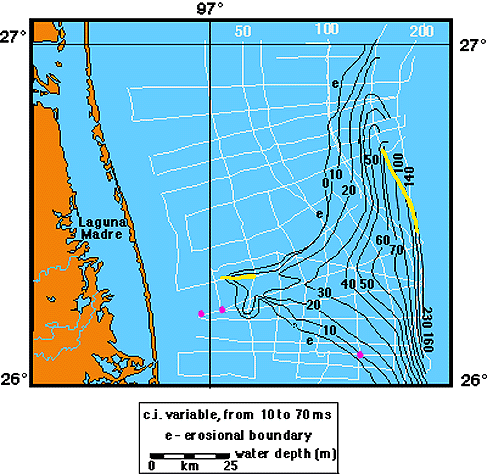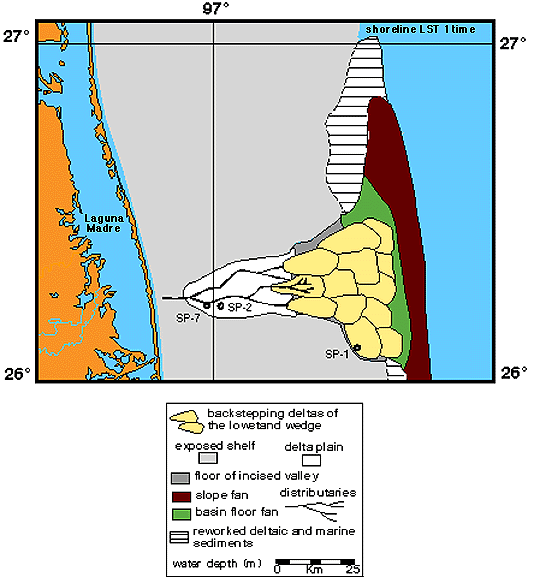South Texas
Lowstand Systems Tract
Lst 1 deposits overlie the Stage 2 sequence boundary and underlie the Stage 2 to 1 transgressive surface. It displays a fan-mound geometry, and is bounded to the west (landward) by erosion. The erosion is caused by the amalgamation of the Stage 2 to 1 transgressive surface with the Stage 2 sequence boundary, although the thickness of lowstand deposits on the shelf is limited by the availability of accommodation space. The abruptness of the boundary is also due to growth faults on the outer shelf.

Line 11a is located on the outer shelf in the northern portion of the study area. The line demonstrates the sigmoid to mounded onlap reflection configuration characteristic of Lst 1 in a dip perspective on the outer shelf. The Lst 1 unit onlaps the underlying Stage 2 sequence boundary and has a slightly erosional to conformable relationship with the overlying Stage 2 to 1 transgressive surface.
Line 24 is a strike line from the outer shelf in the central part of the study area. This line demonstrates the increasing complexity of seismic reflection configurations from north to south: parallel, sub-parallel, divergent, mounded onlapping, and finally chaotic. In a strike view, Lst 1 appears relatively conformable with the underlying Stage 2 sequence boundary and the overlying transgressive surface. The thickness of deposits varies from 10 ms (7.5 m) overlying the diapiric feature in the north to greater than 230 ms (170 m) in the depression in the south.
Line 16/116 is a strike line on the inner shelf in the southern part of the study area. The line shows a cross sectional view of the lowstand incision and the chaotic reflection configuration of the Lst 1 unit.
Line 15 is a dip line from the middle shelf in the central part of the study area. The line demonstrates both the erosional nature of the incision and also the chaotic pattern of Lst 1. This line is also important because it marks the southern limit at which the transgressive surface can be traced reliably on the middle shelf.
Three sediment core descriptions and a generalized core description transect are available for Lst 1.
Unit Lst 1 is interpreted as a delta based on the mounded onlap and sigmoid reflection configurations. The delta is interpreted as fluvially-dominated delta based on the compilation of the lobate fan-mound geometry, the sigmoid to mounded onlap seismic pattern and the lithologic information from the Rio Grande area.


Comments, questions? Contact us at
gulf@gulf.rice.edu.



